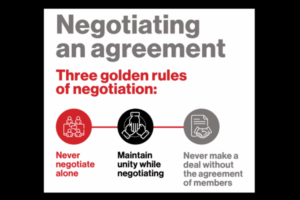The Labour Relations Act (LRA) aims to promote economic development, social justice and labour peace and democracy in workplaces in South Africa.
The LRA recognises the following as legitimate grounds for termination of employment: misconduct, incapacity and operational requirements, also known as retrenchments. Some employers are under the impression that retrenching an employee is as simple as issuing a notice of termination of the employment relationship based on the operational requirements of the company. Another common mistake is to selectively nominate “problem” employees for retrenchment instead of using a fair selection criterion such as the LIFO (Last In First Out) principle recommended by the LRA. Any retrenched worker facing such issues can approach the Commission for Conciliation, Mediation and Arbitration (CCMA) or the Labour Court. Compensation of up to 12 months of the employee’s normal remuneration may be awarded for not following a fair procedure and/or retrenching for a fair reason (procedural and substantive fairness).
The purpose of this article is to explain the rights of employees in terms of section 189(a) of the Labour Relations Act (LRA), and the Basic Conditions of Employment Act (BCEA).
When may an employer retrench employees?
Employers may dismiss employees based on their operational requirement as defined in section 213 of the LRA. ‘Operational requirements’ mean requirements based on the economic, technological, structural or similar needs of an employer. The burden of proof that a genuine operational requirement exists lies with the employer who is required to produce evidence of such a financial crisis. This means an employer can’t merely claim, for example, that the company isn’t making money and as such has to retrench employees.
How can workers be dismissed based on the operational requirements of the employer?
Section 189 of the LRA is applicable and prescribes a joint consensus-seeking process to reach appropriate measures (section 189(2)) for;
- avoiding the dismissals
- minimising the number of dismissals
- changing the timing of the dismissals the timing of the dismissals
- mitigating the adverse effects of the dismissals
- the method for selecting the employees to be dismissed
- the severance pay for dismissed employees.
Who must the employer consult with [section 189(1)]?
The employer must consult with one of the following parties, and in the following order until the appropriate consulting party is identified;
- any person whom the employer is required to consult in terms of a collective agreement
- If there is no collective agreement that requires consultation –> (a) a workplace forum, if the employees likely to be affected by the proposed dismissals are employed in a workplace in respect of which there is a workplace forum; and (b) any registered trade union whose members are likely to be affected by the proposed dismissals;
- In the absence of a workplace forum, any registered trade union whose members are likely to be affected by the proposed dismissals; or
- If there’s no trade union, the employees likely to be affected by the proposed dismissals or their representatives nominated for that purpose.
What information must be disclosed to affected employees [section 189(3)]?
The employer must issue a written notice inviting the other consulting party to consult with it and disclose in writing all relevant information, including, but not limited to: the reasons for the proposed dismissals; the alternatives that the employer considered before proposing the dismissals, and the reasons for rejecting each of those alternatives; the number of employees likely to be affected and the job categories in which they are employed; the proposed method for selecting which employees to dismiss; the time when, or the period during which, the dismissals are likely to take effect; the severance pay proposed; any assistance that the employer proposes to offer to the employees likely to be dismissed; the possibility of the future re-employment of the employees who are dismissed; the number of employees employed by the employer; and the number of employees that the employer has dismissed for reasons based on its operational requirements in the preceding 12 months.
The employer must allow the other consulting party an opportunity during the consultation to make representations about any matter dealt with above, as well as any other matter relating to the proposed dismissals. The employer must consider and respond to the representations made by the other consulting party. If the employer does not agree with the representations made, the reasons for disagreeing must be stated. If any representation is made in writing, the employer must respond in writing.
How long is the joint consensus-seeking process?
The duration of the joint consensus-seeking process entirely depends on the circumstances, which may include the reason for the contemplated dismissals, the complexity of the information disclosed and the number of employees affected. On average, the process takes between two and three weeks.
What are the steps to follow when an employer with more than 50 employees is considering dismissing at least 10 employees based on the company’s operational requirements?
The employer is required to follow the steps outlined in section 189A of the LRA. For this article, the most important points to remember are that:
- Timeframes are prescribed. The employer may effectively not decide to dismiss during the first 30 days or give notice of termination of employment before 60 days lapsed.
- Employees have the right to strike or to refer the matter to the Labour Court once notice has been given by the employer.
How is an employee selected for retrenchment?
The selection criteria that are generally accepted to be fair are the length of service, skills and qualifications. Generally, the test for fair and objective criteria will be satisfied by the use of the “last in first out” (LIFO) principle. There may be instances where the LIFO principle or other criteria needs to be adapted. The LIFO principle should not operate, for example, to undermine an agreed affirmative action programme. Exceptions may also include the retention of employees based on the aforementioned criteria which are fundamental to the successful operation of the business. These exceptions, however, should be treated with caution.
What alternatives to dismissal may be raised by affected employees?
This entirely depends on the circumstances. The affected employees may suggest ways to save or make more money to avoid being retrenched. The employer must consider the suggestions and communicate with the affected employees the reasons for rejecting the suggestions. The most common mistake made by employers is to not consider alternatives suggested by the affected employees. Remember that the primary purpose of the joint consensus-seeking process is to avoid dismissals and the employer must as such be open to workable alternatives. The dismissal of an employee could be found to be substantively unfair if an employer rejected outright reasonable and workable suggestions as an alternative to dismissal.
What suggestions can workers make to the company to avoid retrenchment?
Some common suggestions that employees can put forward include: measures to increase productivity; short time; rationalizing costs and expenditure; increase or decrease in shifts and length of shifts; decreasing the number of contractors or casual labourers; using employees to perform the functions performed by contractors or casual labourers; the employer outsourcing a function to its own staff after the employees have formed themselves into a company; skills development to enable employees to move into different positions; stopping overtime or Sunday work; reducing wages (by agreement); early retirement offers or schemes; moratoriums on hiring new employees; gradual reduction of workforce by way of natural turnover; extended unpaid leave or temporary lay-off.
How much is severance pay?
Employees are entitled to one (1) week’s severance pay for each completed and continuous year of service with the same employer. The employer does not have to pay severance if an employee unreasonably refuses to accept an offer of employment with the current employer or another employer (sections 41(2), 41(4) of the BCEA). Remember that severance pay for employees that fall under the scope of a bargaining council may be different from the minimum prescribed by the BCEA.
How is severance pay calculated?
The following payments are included in an employee’s remuneration to calculate severance pay, according to the determination issued by the Minister of Employment and Labour in Government Notice 691 of 2003:
- housing or accommodation allowance or subsidy; or housing or accommodation received as a benefit in kind. Any housing or accommodation allowance or subsidy paid in cash, or the value thereof if paid in kind, is deemed to be part of remuneration.
- car allowance or the value of provision of a company car. This does not apply if the employer provides a vehicle to the employee to travel to and from work, with no other private usage of the vehicle by the employee.
- any cash payments made to an employee, except those listed as exclusions below.
- employer’s contributions to medical aid, pension, provident or similar funds or schemes
- employer’s contributions to funeral or death benefit schemes
The following items do not form part of the employee’s remuneration for the purpose of these calculations:
- any cash payment or payment in kind that is provided to enable the employee to work (for example, equipment, tools or a similar allowance, or the provision of transport or the payment of a transport allowance to enable the employee to travel to and from work only)
- a relocation allowance
- gratuities, for example, tips received from customers, and gifts received from the employer
- share incentive schemes
- discretionary payments not related to the employee’s hours of work or performance, for example, a discretionary profit-sharing scheme.
- an entertainment allowance
- an education or schooling allowance.
The value of payments in kind must be determined as follows:
- a value agreed to in either a contract of employment or collective agreement, provided that the agreed value may not be less than the cost to the employer of providing the payment in kind; or
- the cost to the employer of providing the payment in kind.
An employee is not entitled to a payment or the cash value of a payment in kind as part of the remuneration if:
- the employee received the payment or enjoyed, or was entitled to enjoy, the payment in kind during the relevant period.
- in the case of a contribution to a fund or scheme that forms part of the remuneration, the employer paid a contribution in respect of the relevant period.
If the payment fluctuates, it must be calculated over 13 weeks or if the employee has been in employment for a shorter period, over that period.
A payment received in a particular period in respect of a longer period (e.g. a 13th cheque) must be calculated pro rata.
This schedule applies only to the minimum payments that an employer is required to make in terms of the BCEA, 1977.
Note that where the employee’s remuneration fluctuates regularly, the calculation of payment for annual leave must be based on the employee’s average earnings for the previous 13 weeks. The average will include commission and or overtime paid for.
Can an employee still draw unemployment benefits after taking a retrenchment package under ‘voluntary retrenchment’?
Yes, as long as the employee can prove that the employer initiated the voluntary offer.
Must an employee be given notice of termination of employment and must such notice be paid?
Yes, retrenchments are “no-fault” dismissals. It is not the fault of the employee that the company cannot afford the salary of the employee anymore and therefore notice periods agreed upon must be honoured. The employer may ask the employee not to return to work but must then pay the notice period.
What happens to annual leave when an employee is retrenched?
The employer must pay the accumulated annual leave.
***Jan du Toit is Senior Consultant at South African Labour Guide







